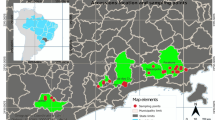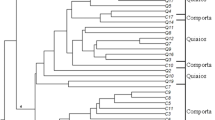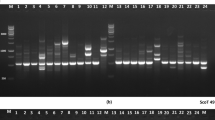Abstract
Annatto (Bixa orellana L.) is a tropical crop indigenous to the Americas, probably Amazonia. Annatto is commercially valuable in the food and cosmetics industries as a natural dye used instead of synthetic dyes. In addition, annatto contains other important substances for human health, such as geranylgeraniol, tocotrienols and other carotenoids. The aim of the present study was to evaluate the genetic diversity of 63 accessions from the annatto germplasm bank at the Agronomic Institute (IAC), São Paulo, Brazil, using four phytochemical compounds and 16 microsatellite markers. Significant variation was observed for the phytochemical compounds, ranging from 2 to 7.31 g (100 g dry matter—DM)−1 for bixin, 2.14–7.11 g (100 g DM)−1 for lipids, 0.25–1.05 g (100 g DM)−1 for tocotrienols, and 0.49–2.61 g (100 g DM)−1 for geranylgeraniol content. A total of 73 alleles was observed in the molecular characterization with 16 microsatellite loci. We found higher expected heterozygosity than observed heterozygosity for all loci, indicating strong deficits of heterozygotes. For both molecular and phytochemical compounds, cluster and PCoA analyses tended to separate the accessions from Rondônia, northern Brazil, with only a few exceptions, from the Southwestern accessions. The same two groups were found in the Bayesian analysis with molecular data. Rondônia accessions showed higher values for all the phytochemical compounds and higher levels of genetic diversity. Some accessions presented bixin levels well above the average and are promising materials to be used in genetic improvement programs.






Similar content being viewed by others
References
Akshatha V, Giridhar P, Ravishankar GA (2011) Morphological diversity in Bixa orellana L. and variations in annatto pigment yield. J Hortic Sci Biotechnol 86:319–324. doi:10.1080/14620316.2011.11512767
Albuquerque CLC, Meireles MAA (2012) Defatting of annatto seeds using supercritical carbon dioxide as a pretreatment for the production of bixin: experimental, modeling and economic evaluation of the process. J Supercrit Fluids 66:86–95. doi:10.1016/j.supflu.2012.01.004
Alves RW, de Souza AAU, Souza SMAGU, Jauregi P (2006) Recovery of norbixin from a raw extraction solution of annatto pigments using colloidal gas aphrons (CGAs). Sep Purif Technol 48:208–213. doi:10.1016/j.seppur.2005.07.014
Arce J (1999) El achiote Bixa orellana L: cultivo promisorio para el trópico. Earth, Turrialba
Auttachoat W, Germolec DR, Smith MJ et al (2011) Contact sensitizing potential of annatto extract and its two primary color components, cis-bixin and norbixin, in female BALB/c mice. Food Chem Toxicol 49:2638–2644. doi:10.1016/j.fct.2011.07.009
Baer DF (1976) Systematics of the genus Bixa and geography of the cultivated annatto tree. PhD thesis, University of California
Carvalho PRN, Carvalho CRL, Mantovani DMB (1991) Estudo da composição de sementes, cachopas, folhas e galhos do urucueiro. In: Proceedings of the seminário internacional de Corantes naturais para alimento. p 317
Carvalho PRN, da Silva MG, Moreira CGC (1993) Avaliaçäo dos métodos espectrofotométricos de análise de sementes de urucum (Bixa orellana L.). Colet Inst Tecnol Aliment 23:181–188
Carvalho PRN, da Silva MG, Fabri EG et al (2010) Concentração de bixina e lipidios em sementes de urucum da coleção do Instituto Agronômico (IAC). Bragantia 69:519–524
Clement CR, de Cristo-Araújo M, d’Eeckenbrugge GC et al (2010) Origin and domestication of native Amazonian crops. Diversity 2:72–106. doi:10.3390/d2010072
Craveiro AR, Oliveira CLA, Araujo FWL (1989) The presence of geranylgeraniol in Bixa orellana Linn. Quim Nova 12:297–298
de Carvalho JFRP, Robinson IP, Alfenas AC (2005) Isozymic variability in a Brazilian collection of annatto (Bixa orellana L.). Pesqui Agropecu Bras 40:653–660. doi:10.1590/S0100-204X2005000700005
Dequigiovanni G, Ramos SLF, Zucchi MI et al (2014) Isolation and characterization of microsatellite loci for Bixa orellana, an important source of natural dyes. Genet Mol Res 13:9097–9102. doi:10.4238/2014.October.31.25
Doyle JJ, Doyle JL (1990) Isolation of plant DNA from fresh tissue. Focus 12:13–15
Dray S, Dufour A-B (2007) The ade4 Package: implementing the duality diagram for ecologists. J Stat Softw 22:1–20. doi:10.18637/jss.v022.i04
Earl DA, vonHoldt BM (2012) STRUCTURE HARVESTER: a website and program for visualizing STRUCTURE output and implementing the Evanno method. Conserv Genet Resour 4:359–361. doi:10.1007/s12686-011-9548-7
Evanno G, Regnaut S, Goudet J (2005) Detecting the number of clusters of individuals using the software STRUCTURE: a simulation study. Mol Ecol 14:2611–2620. doi:10.1111/j.1365-294X.2005.02553.x
Fabri EG (2015) Demanda por corantes naturais aquece mercado brasileiro de urucum. Sociedade Nacional de Agricultura. http://sna.agr.br/demanda-por-corantes-naturais-aquece-mercado-brasileiro-de-urucum. Accessed 26 Nov 2015
Forzza RC et al (2010) Lista de espécies da flora do Brasil. Jardim Botânico do Rio de Janeiro, Rio de Janeiro
Franco CFO, Fabri EG, Barreiro Neto M et al (2008) Urucum: sistemas de produção para o Brasil. EMEPA, João Pessoa
Frankham R, Ballou JD, Briscoe DA (2004) A primer of conservation genetics. Cambridge University Press, Cambridge
Frega N, Mozzon M, Bocci F (1998) Identification and estimation of tocotrienols in the annatto lipid fraction by gas chromatography-mass spectrometry. J Am Oil Chem Soc 75:1723–1727. doi:10.1007/s11746-998-0323-1
Giorgi A, De Marinis P, Granelli G et al (2013) Secondary metabolite profile, antioxidant capacity, and mosquito repellent activity of Bixa orellana from Brazilian Amazon region. J Chem. doi:10.1155/2013/409826
Giuliano G, Rosati C, Bramley PM (2003) To dye or not to dye: biochemistry of annatto unveiled. Trends Biotechnol 21:513–516. doi:10.1016/j.tibtech.2003.10.001
Hartl D, Clark A (1998) Principles of population genetics. Sinauer Associates, Sunderland
Horwitz W (2005) Official methods of analysis of the association of official analytical chemists, 18th edn. AOAC, Gaithersburg
Jondiko IJO, Pattenden G (1989) Terpenoids and an apocarotenoid from seeds of Bixa orellana. Phytochemistry 28:3159–3162. doi:10.1016/0031-9422(89)80298-5
Kalia RK, Rai MK, Kalia S et al (2011) Microsatellite markers: an overview of the recent progress in plants. Euphytica 177:309–334. doi:10.1007/s10681-010-0286-9
Keenan K, McGinnity P, Cross TF et al (2013) diveRsity: an R package for the estimation and exploration of population genetics parameters and their associated errors. Methods Ecol Evol 4:782–788. doi:10.1111/2041-210X.12067
Langella O (2002) Populations, 1.2.32. Population genetic software. http://bioinformatics.org/~tryphon/populations. Accessed 30 Aug 2016
Leal F, Clavijo CM (2010) Acerca de la história, taxonomia, botánica y usos de Bixa orellana L. Rev Unell Cienc Tec 1:78–86
Leal F, de Clavijo CM (2012) Annatto: botany and horticulture. In: Janick J (ed) Horticultural Reviews. Wiley, Hoboken, p 389–419
Lopes MV, Desoti VC, Caleare ADO et al (2012) Mitochondria superoxide anion production contributes to geranylgeraniol-induced death in leishmania amazonensis. Evid Based Complement Alternat Med 2012:298320. doi:10.1155/2012/298320
Mantovani NC, Grando MF, Xavier A, Otoni WC (2013) Avaliação de genótipos de urucum (Bixa orellana L.) por meio da caracterização morfológica de frutos, produtividade de sementes e teor de bixina. Cienc Florest 23:344–362. doi:10.5902/198050989281
Matos FJA, Alencar JW, Craveiro AA, Machado MIL (1992) Acidos graxos de algumas oleaginosas tropicais em ocorrência no nordeste brasileiro. Quim Nova 15:181–195
Monzote L, Montalvo AM, Almanonni S et al (2006) Activity of the essential oil from Chenopodium ambrosioides grown in Cuba against Leishmania amazonensis. Chemotherapy 52:130–136. doi:10.1159/000092858
Moreira PA, Lins J, Dequigiovanni G et al (2015) The domestication of annatto (Bixa orellana) from Bixa urucurana in Amazonia. Econ Bot 69:127–135. doi:10.1007/s12231-015-9304-0
Nisar N, Li L, Lu S et al (2015) Carotenoid metabolism in plants. Mol Plant 8:68–82. doi:10.1016/j.molp.2014.12.007
Panfili G, Fratianni A, Irano M (2003) Normal phase high-performance liquid chromatography method for the determination of tocopherols and tocotrienols in cereals. J Agric Food Chem 51:3940–3944. doi:10.1021/JF030009V
Peakall R, Smouse PE (2012) GenAlEx 6.5: genetic analysis in Excel. Population genetic software for teaching and research-an update. Bioinformatics 28:2537–2539
Pritchard JK, Stephens M, Donnelly P (2000) Inference of population structure using multilocus genotype data. Genetics 155:945–959
R Core Team (2015) R: A language and environment for statistical computing. R Foundation for statistical computing, Vienna, Austria. https://www.R-project.org/
Rambaut A, Drummond A (2010) FigTree v1.3.1. Institute of Evolutionary Biology, University of Edinburgh, UK. http://tree.bio.ed.ac.uk/software/figtree/. Accessed 2 Apr 2013
Rao PP, Rao NG, Jyothirmayi T et al (2015) Characterisation of seed lipids from Bixa orellana and Trachyspermum copticum. J Am Oil Chem Soc 92:1483–1490. doi:10.1007/s11746-015-2717-1
Ritland K (2002) Extensions of models for the estimation of mating systems using n independent loci. Heredity 88:221–228. doi:10.1038/sj.hdy.6800029
Rivera-Madrid R, Escobedo-GM RM, Balam-Galera E et al (2006) Preliminary studies toward genetic improvement of annatto (Bixa orellana L.). Sci Hortic 109:165–172. doi:10.1016/j.scienta.2006.03.011
Rodrigues J (1995) Análise de isoenzimas em progênies de meio-irmãos de urucum (Bixa orellana L.). Federal University of Viçosa, Viçosa
Rogers J (1972) Measures of genetic similarity and genetic distances. In: Studies in genetics VII. University of Texas Publication, Austin, pp. 145–153
Saitou N, Nei M (1987) The neighbor-joining method: a new method for reconstructing phylogenetic trees. Mol Biol Evol 4:406–425
Sandy-Cuen PM, Becerra R (2003) Manejo campesino de recursos naturales. El achiote. BioDiversitas 7:7–11
Schuelke M (2000) An economic method for the fluorescent labeling of PCR fragments. Nat Biotechnol 18:233–234. doi:10.1038/72708
Sen CK, Khanna S, Roy S (2007) Tocotrienols in health and disease: the other half of the natural vitamin E family. Mol Aspects Med 28:692–728
Smith J, Wallin H (2006) Annatto extracts. Chemical and technical assessment ftp://ftp.fao.org/ag/agn/jecfa/cta_annatto.pdf.
Stringheta CP, Silva PI (2008) Pigmentos de urucum. Extração, reações químicas, uso e aplicações, 1st edn. Suprema, Viçosa
Tan B, Foley J (2000) Tocotrienols and geranylgeraniol from Bixa orellana byproducts. WO Pat. US6350453 B1
Vieira MLC, Santini L, Diniz AL, Munhoz CF (2016) Microsatellite markers: what they mean and why they are so useful. Genet Mol Biol 39:312–328. doi:10.1590/1678-4685-GMB-2016-0027
Vilar DA, Vilar MSA, de Lima e Moura TFA et al (2014) Traditional uses, chemical constituents, and biological activities of Bixa orellana L.: a review. Sci World J 857292:1–11. doi:10.1155/2014/857292
Vilares AS, São José AR, Rebouças TNH, Souza IVB (1992) Estudo da biologia floral de urucuzeiro (Bixa orellana L.). Rev Bras Corantes Nat 1:101–105
Weir BS (1996) Genetic data analysis II: methods for discrete population genetic data. Sinauer Associates, Sunderland
Zahn TJ, Eilers M, Guo Z et al (2000) Evaluation of isoprenoid conformation in solution and in the active site of protein-farnesyl transferase using carbon-13 labeling in conjunction with solution- and solid-state NMR. J Am Chem Soc 122:7153. doi:10.1021/ja000860f
Acknowledgements
This project was financially supported by São Paulo Research Foundation—FAPESP (2011/10357-8; 2012/08307-5). G. D. was supported by FAPESP with MSc and PhD scholarships (2011/05243-3; 2013/08884-5). E.A.V. and C.R.C. were supported by National Council for Scientific and Technological Development (CNPq) research fellowships. Authors wish to thank Instituto Agronômico—IAC/APTA, for providing the annatto samples from the annatto Germplasm Bank for this study, and Polo Regional Centro Norte—PRDTA/APTA in Pindorama-SP, for maintaining the annatto Germplasm Bank.
Author information
Authors and Affiliations
Corresponding authors
Ethics declarations
Conflicts of interest
The authors declare that there are no conflicts of interest.
Electronic supplementary material
Below is the link to the electronic supplementary material.
Rights and permissions
About this article
Cite this article
Dequigiovani, G., Ramos, S.L.F., Alves-Pereira, A. et al. Genetic diversity and structure in a major Brazilian annatto (Bixa orellana) germplasm bank revealed by microsatellites and phytochemical compounds. Genet Resour Crop Evol 64, 1775–1788 (2017). https://doi.org/10.1007/s10722-017-0535-z
Received:
Accepted:
Published:
Issue Date:
DOI: https://doi.org/10.1007/s10722-017-0535-z




